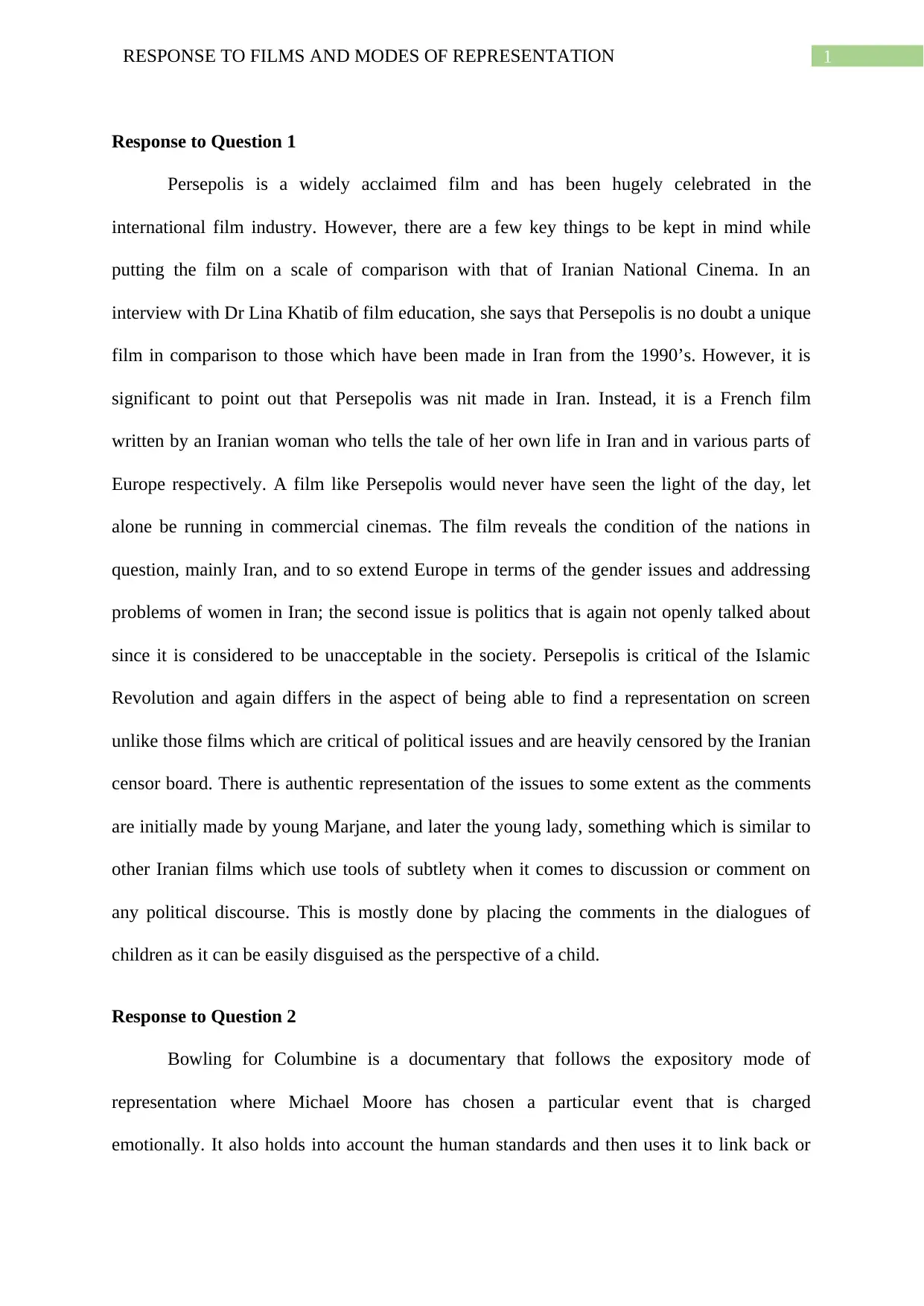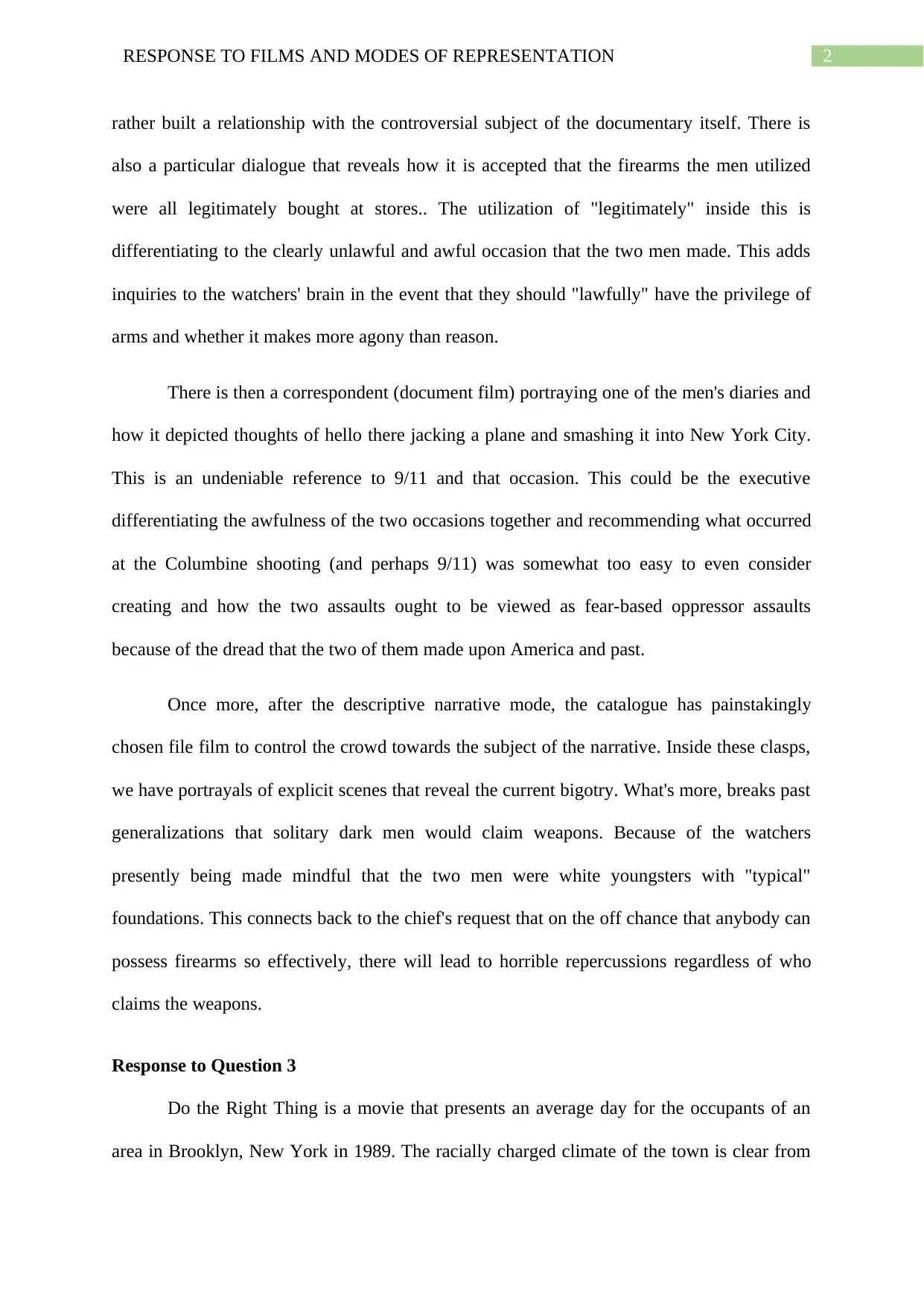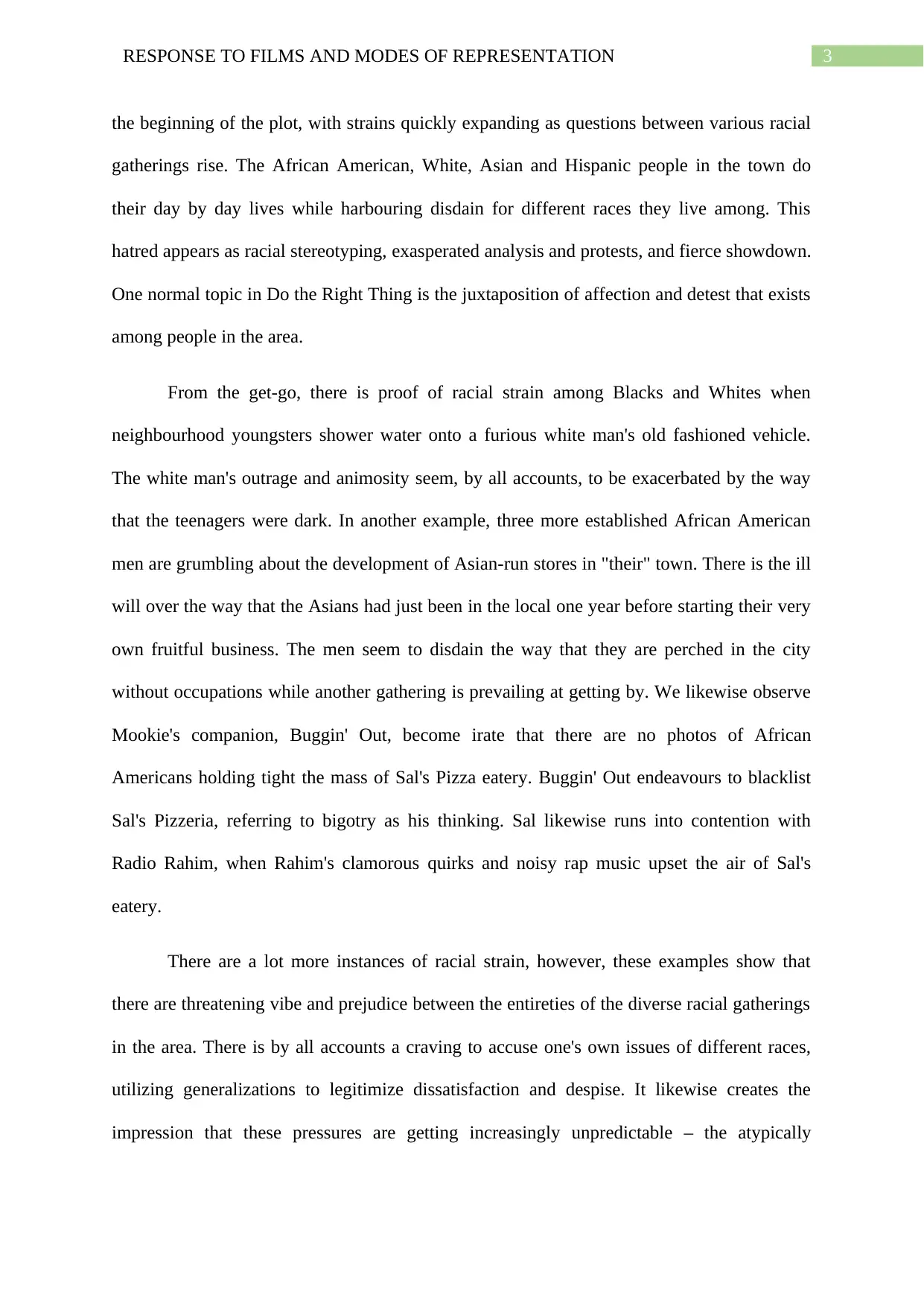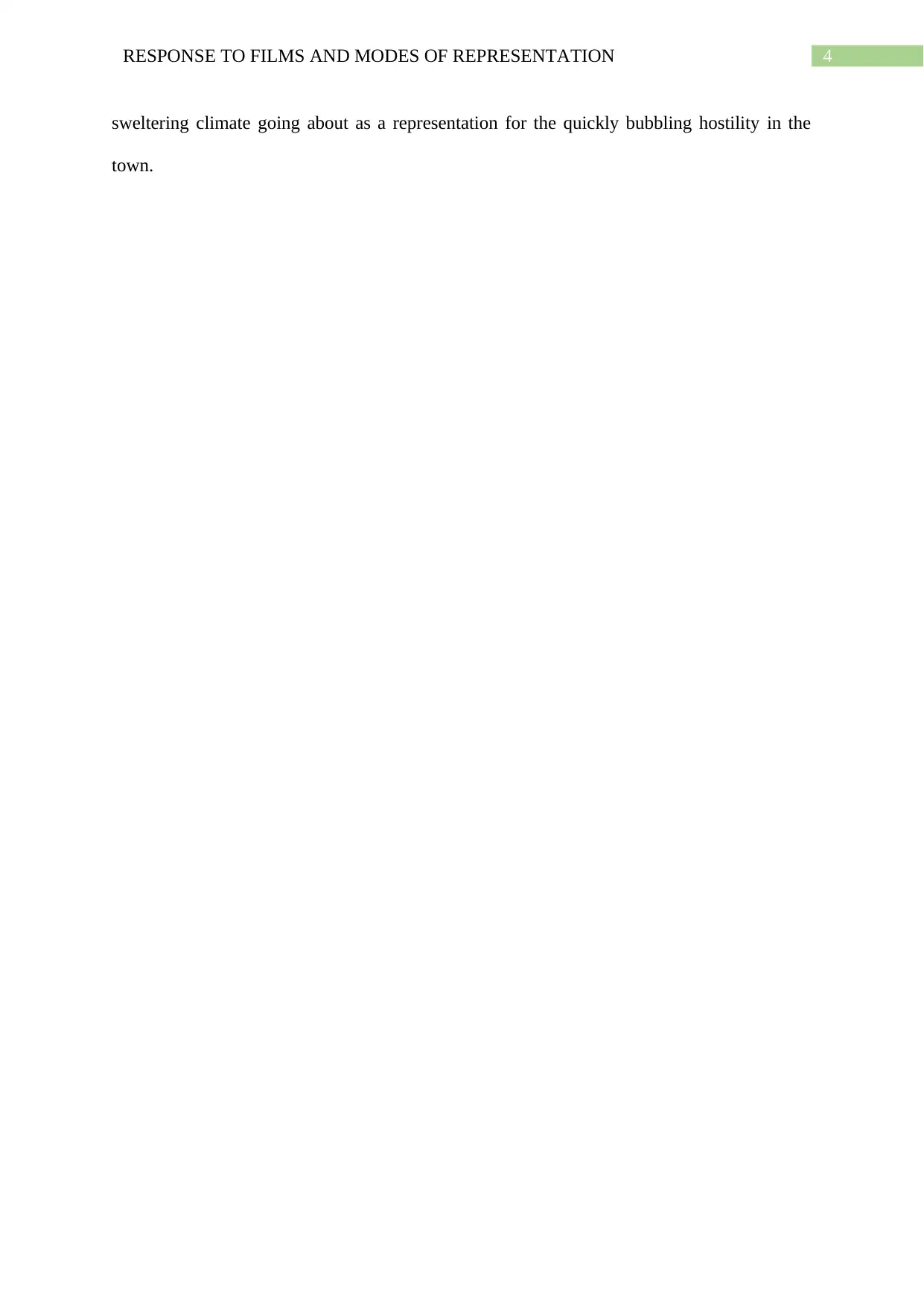Analysis of Film Representation: Persepolis, Bowling for Columbine...
VerifiedAdded on 2022/09/25
|5
|1164
|22
Report
AI Summary
This report provides an analysis of three films: Persepolis, Bowling for Columbine, and Do the Right Thing, focusing on their modes of representation and the issues they address. The report begins by comparing Persepolis to Iranian National Cinema, noting its unique perspective as a French film by an Iranian author and its critical stance on gender and political issues. It then analyzes Bowling for Columbine, examining its use of the expository mode, its commentary on gun violence, and its portrayal of racial issues. Finally, the report examines Do the Right Thing, exploring the racial tensions and stereotypes present in the film, and how these tensions are depicted through the juxtaposition of love and hate within a diverse community. The analysis highlights the films' different approaches to storytelling and their respective explorations of social and political themes.

Running Head: RESPONSE TO FILMS AND MODES OF REPRESENTATION
Response to films and Modes of Representation
Name of the Student:
Name of the University:
Author Note:
Response to films and Modes of Representation
Name of the Student:
Name of the University:
Author Note:
Paraphrase This Document
Need a fresh take? Get an instant paraphrase of this document with our AI Paraphraser

1RESPONSE TO FILMS AND MODES OF REPRESENTATION
Response to Question 1
Persepolis is a widely acclaimed film and has been hugely celebrated in the
international film industry. However, there are a few key things to be kept in mind while
putting the film on a scale of comparison with that of Iranian National Cinema. In an
interview with Dr Lina Khatib of film education, she says that Persepolis is no doubt a unique
film in comparison to those which have been made in Iran from the 1990’s. However, it is
significant to point out that Persepolis was nit made in Iran. Instead, it is a French film
written by an Iranian woman who tells the tale of her own life in Iran and in various parts of
Europe respectively. A film like Persepolis would never have seen the light of the day, let
alone be running in commercial cinemas. The film reveals the condition of the nations in
question, mainly Iran, and to so extend Europe in terms of the gender issues and addressing
problems of women in Iran; the second issue is politics that is again not openly talked about
since it is considered to be unacceptable in the society. Persepolis is critical of the Islamic
Revolution and again differs in the aspect of being able to find a representation on screen
unlike those films which are critical of political issues and are heavily censored by the Iranian
censor board. There is authentic representation of the issues to some extent as the comments
are initially made by young Marjane, and later the young lady, something which is similar to
other Iranian films which use tools of subtlety when it comes to discussion or comment on
any political discourse. This is mostly done by placing the comments in the dialogues of
children as it can be easily disguised as the perspective of a child.
Response to Question 2
Bowling for Columbine is a documentary that follows the expository mode of
representation where Michael Moore has chosen a particular event that is charged
emotionally. It also holds into account the human standards and then uses it to link back or
Response to Question 1
Persepolis is a widely acclaimed film and has been hugely celebrated in the
international film industry. However, there are a few key things to be kept in mind while
putting the film on a scale of comparison with that of Iranian National Cinema. In an
interview with Dr Lina Khatib of film education, she says that Persepolis is no doubt a unique
film in comparison to those which have been made in Iran from the 1990’s. However, it is
significant to point out that Persepolis was nit made in Iran. Instead, it is a French film
written by an Iranian woman who tells the tale of her own life in Iran and in various parts of
Europe respectively. A film like Persepolis would never have seen the light of the day, let
alone be running in commercial cinemas. The film reveals the condition of the nations in
question, mainly Iran, and to so extend Europe in terms of the gender issues and addressing
problems of women in Iran; the second issue is politics that is again not openly talked about
since it is considered to be unacceptable in the society. Persepolis is critical of the Islamic
Revolution and again differs in the aspect of being able to find a representation on screen
unlike those films which are critical of political issues and are heavily censored by the Iranian
censor board. There is authentic representation of the issues to some extent as the comments
are initially made by young Marjane, and later the young lady, something which is similar to
other Iranian films which use tools of subtlety when it comes to discussion or comment on
any political discourse. This is mostly done by placing the comments in the dialogues of
children as it can be easily disguised as the perspective of a child.
Response to Question 2
Bowling for Columbine is a documentary that follows the expository mode of
representation where Michael Moore has chosen a particular event that is charged
emotionally. It also holds into account the human standards and then uses it to link back or

2RESPONSE TO FILMS AND MODES OF REPRESENTATION
rather built a relationship with the controversial subject of the documentary itself. There is
also a particular dialogue that reveals how it is accepted that the firearms the men utilized
were all legitimately bought at stores.. The utilization of "legitimately" inside this is
differentiating to the clearly unlawful and awful occasion that the two men made. This adds
inquiries to the watchers' brain in the event that they should "lawfully" have the privilege of
arms and whether it makes more agony than reason.
There is then a correspondent (document film) portraying one of the men's diaries and
how it depicted thoughts of hello there jacking a plane and smashing it into New York City.
This is an undeniable reference to 9/11 and that occasion. This could be the executive
differentiating the awfulness of the two occasions together and recommending what occurred
at the Columbine shooting (and perhaps 9/11) was somewhat too easy to even consider
creating and how the two assaults ought to be viewed as fear-based oppressor assaults
because of the dread that the two of them made upon America and past.
Once more, after the descriptive narrative mode, the catalogue has painstakingly
chosen file film to control the crowd towards the subject of the narrative. Inside these clasps,
we have portrayals of explicit scenes that reveal the current bigotry. What's more, breaks past
generalizations that solitary dark men would claim weapons. Because of the watchers
presently being made mindful that the two men were white youngsters with "typical"
foundations. This connects back to the chief's request that on the off chance that anybody can
possess firearms so effectively, there will lead to horrible repercussions regardless of who
claims the weapons.
Response to Question 3
Do the Right Thing is a movie that presents an average day for the occupants of an
area in Brooklyn, New York in 1989. The racially charged climate of the town is clear from
rather built a relationship with the controversial subject of the documentary itself. There is
also a particular dialogue that reveals how it is accepted that the firearms the men utilized
were all legitimately bought at stores.. The utilization of "legitimately" inside this is
differentiating to the clearly unlawful and awful occasion that the two men made. This adds
inquiries to the watchers' brain in the event that they should "lawfully" have the privilege of
arms and whether it makes more agony than reason.
There is then a correspondent (document film) portraying one of the men's diaries and
how it depicted thoughts of hello there jacking a plane and smashing it into New York City.
This is an undeniable reference to 9/11 and that occasion. This could be the executive
differentiating the awfulness of the two occasions together and recommending what occurred
at the Columbine shooting (and perhaps 9/11) was somewhat too easy to even consider
creating and how the two assaults ought to be viewed as fear-based oppressor assaults
because of the dread that the two of them made upon America and past.
Once more, after the descriptive narrative mode, the catalogue has painstakingly
chosen file film to control the crowd towards the subject of the narrative. Inside these clasps,
we have portrayals of explicit scenes that reveal the current bigotry. What's more, breaks past
generalizations that solitary dark men would claim weapons. Because of the watchers
presently being made mindful that the two men were white youngsters with "typical"
foundations. This connects back to the chief's request that on the off chance that anybody can
possess firearms so effectively, there will lead to horrible repercussions regardless of who
claims the weapons.
Response to Question 3
Do the Right Thing is a movie that presents an average day for the occupants of an
area in Brooklyn, New York in 1989. The racially charged climate of the town is clear from
⊘ This is a preview!⊘
Do you want full access?
Subscribe today to unlock all pages.

Trusted by 1+ million students worldwide

3RESPONSE TO FILMS AND MODES OF REPRESENTATION
the beginning of the plot, with strains quickly expanding as questions between various racial
gatherings rise. The African American, White, Asian and Hispanic people in the town do
their day by day lives while harbouring disdain for different races they live among. This
hatred appears as racial stereotyping, exasperated analysis and protests, and fierce showdown.
One normal topic in Do the Right Thing is the juxtaposition of affection and detest that exists
among people in the area.
From the get-go, there is proof of racial strain among Blacks and Whites when
neighbourhood youngsters shower water onto a furious white man's old fashioned vehicle.
The white man's outrage and animosity seem, by all accounts, to be exacerbated by the way
that the teenagers were dark. In another example, three more established African American
men are grumbling about the development of Asian-run stores in "their" town. There is the ill
will over the way that the Asians had just been in the local one year before starting their very
own fruitful business. The men seem to disdain the way that they are perched in the city
without occupations while another gathering is prevailing at getting by. We likewise observe
Mookie's companion, Buggin' Out, become irate that there are no photos of African
Americans holding tight the mass of Sal's Pizza eatery. Buggin' Out endeavours to blacklist
Sal's Pizzeria, referring to bigotry as his thinking. Sal likewise runs into contention with
Radio Rahim, when Rahim's clamorous quirks and noisy rap music upset the air of Sal's
eatery.
There are a lot more instances of racial strain, however, these examples show that
there are threatening vibe and prejudice between the entireties of the diverse racial gatherings
in the area. There is by all accounts a craving to accuse one's own issues of different races,
utilizing generalizations to legitimize dissatisfaction and despise. It likewise creates the
impression that these pressures are getting increasingly unpredictable – the atypically
the beginning of the plot, with strains quickly expanding as questions between various racial
gatherings rise. The African American, White, Asian and Hispanic people in the town do
their day by day lives while harbouring disdain for different races they live among. This
hatred appears as racial stereotyping, exasperated analysis and protests, and fierce showdown.
One normal topic in Do the Right Thing is the juxtaposition of affection and detest that exists
among people in the area.
From the get-go, there is proof of racial strain among Blacks and Whites when
neighbourhood youngsters shower water onto a furious white man's old fashioned vehicle.
The white man's outrage and animosity seem, by all accounts, to be exacerbated by the way
that the teenagers were dark. In another example, three more established African American
men are grumbling about the development of Asian-run stores in "their" town. There is the ill
will over the way that the Asians had just been in the local one year before starting their very
own fruitful business. The men seem to disdain the way that they are perched in the city
without occupations while another gathering is prevailing at getting by. We likewise observe
Mookie's companion, Buggin' Out, become irate that there are no photos of African
Americans holding tight the mass of Sal's Pizza eatery. Buggin' Out endeavours to blacklist
Sal's Pizzeria, referring to bigotry as his thinking. Sal likewise runs into contention with
Radio Rahim, when Rahim's clamorous quirks and noisy rap music upset the air of Sal's
eatery.
There are a lot more instances of racial strain, however, these examples show that
there are threatening vibe and prejudice between the entireties of the diverse racial gatherings
in the area. There is by all accounts a craving to accuse one's own issues of different races,
utilizing generalizations to legitimize dissatisfaction and despise. It likewise creates the
impression that these pressures are getting increasingly unpredictable – the atypically
Paraphrase This Document
Need a fresh take? Get an instant paraphrase of this document with our AI Paraphraser

4RESPONSE TO FILMS AND MODES OF REPRESENTATION
sweltering climate going about as a representation for the quickly bubbling hostility in the
town.
sweltering climate going about as a representation for the quickly bubbling hostility in the
town.
1 out of 5
Your All-in-One AI-Powered Toolkit for Academic Success.
+13062052269
info@desklib.com
Available 24*7 on WhatsApp / Email
![[object Object]](/_next/static/media/star-bottom.7253800d.svg)
Unlock your academic potential
Copyright © 2020–2025 A2Z Services. All Rights Reserved. Developed and managed by ZUCOL.